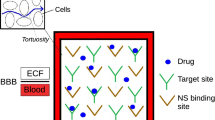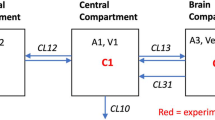Abstract
The equilibration between drug serum concentration and drug effect under non-steady state concentrations has been classically modeled using an effect compartment where the transfer from the serum to the effect compartment is considered to be a first-order process. The purpose of the present study was to examine whether an effect compartment with first-order transfer was adequate for describing thiopental serum concentration-EEG pharmacodynamics. The study has two facets: (i) Successive pseudo steady state serum concentrations of thiopental having a square wave shape were produced and maintained in six human subjects by means of a computer-driven infusion pump. An aperiodic wave form transformation of the electroencephalogram (EEG) was used as a continuous measure of thiopental EEG drug effect. The time course of the EEG effect following each thiopental serum concentration square wave showed an exponential pattern. The first-order rate constant for equilibration of the effect site concentration with the drug serum concentration (k eo ) was estimated by fitting a monoexponential model to the effect vs. time data resulting from the pseudo steady state thiopental serum concentration profile, (ii) In a second experiment, data were obtained from a classical design, i.e., a zero-order intravenous infusion of thiopental. The same subjects were studied. The k eo was estimated by means of a semipammetric iterative method using convolution (effect compartment, transfer of drug from serum to site of action is assumed to be a first-order process). The mean pseudo steady state value for k eo of 0.51 min −1 was not different from the mean value of 0.46 min −1 from the semi parametric approach when data from a linear portion of the drug concentration vs. effect curve were examined. The pseudo steady state technique gave inaccurate estimates of k eo in the nonlinear portion of the thiopental concentration vs. response curve, i.e., at the peak of the biphasic concentration-effect relationship.
Similar content being viewed by others
References
R. L. Galeazzi, L. Z. Benet, and L. B. Sheiner. Relationship between the pharmacokinetics and pharmacodynamics of procainamide.Clin. Pharmacol. Ther. 20:278–289 (1976).
G. Sergé. Kinetics of interaction between drugs and biological systems.Farmaco [Ed. Sci.]23:907–918 (1968).
C. J. Hull, H. B. H. Van Beem, K. McLeod, A. Sibbald, and M. J. Watson. A pharmacodynamic model for pancuronium.Br. J. Anaesth. 50:1113–1123 (1978).
L. B. Sheiner, D. R. Stanski, S. Vozeh, R. D. Miller, and J. Ham. Simultaneous modeling of pharmacokinetics and pharmacodynamics: Application tod-tubocurarine.Clin. Pharmacol. Ther. 25:358–371 (1979).
E. Fuseau and L. B. Sheiner. Simultaneous modeling of pharmacokinetics and pharmacodynamics with a non-parametric pharmacodynamic model.Clin. Pharmacol. Ther. 35:733–741 (1984).
J. D. Unadkat, F. Bartha, and L. B. Sheiner. Simultaneous modeling of pharmacokinetics and pharmacodynamics with nonparametric kinetic and dynamic models.Clin. Pharmacol. Ther. 40:86–93 (1986).
D. Verotta and L. B. Sheiner. Simultaneous modeling of pharmacokinetics and pharmacodynamics: An improved algorithm.CABIOS. 3:345–349 (1987).
D. R. Stanski and L. B. Sheiner. Pharmacokinetics and pharmacodynamics of muscle relaxants.Anesthesiology 51:103–105 (1979).
D. R. Stanski, P. G. Burch, S. Harapat, and R. K. Richards. Pharmacokinetics and anesthetic potency of a thiopental isomer.J. Pharm. Sci. 72:937–940 (1983).
T. K. Gregory and D. C. Pettus. An electroencephalographic processing algorithm specifically intended for analysis of cerebral electrical activity.J. Clin. Monit. 2:190–197 (1986).
M. E. Ausems, D. R. Stanski, and C. C. Hug, Jr. An evaluation of the accuracy of pharmacokinetic data for the computer-assisted infusion of alfentanil.Br. J. Anesth. 57:1217–1225 (1987).
S. L. Shafer, L. C. Siegel, J. E. Cooke, and J. C. Scott. Testing computer-controlled infusion pumps by simulation.Anesthesiology 68:261–266 (1988).
T. D. Homer and D. R. Stanski, The effect of increasing age on thiopental disposition and anesthetic requirement.Anesthesiology 62:714–724 (1985).
N. H. Holford,MKMODEL User's Manual, Elsevier, Cambridge, England, 1986.
E. C. Pierce, C. J. Lambertson, S. Deutch, P. E. Chase, H. W. Linde, R. D. Drips, and H. L. Price. Cerebral circulation and metabolism during thiopental anesthesia and hyperventilation in man.J. Clin. Invest. 41:1664–1671 (1962).
Author information
Authors and Affiliations
Additional information
This work was supported by the Veterans Adminstration Merit Review, NIA Grant P01-AG-03104, and the Anesthesiology/Pharmacology Research Foundation. Dr. Maitre was supported by the Swiss National Science Foundation.
Rights and permissions
About this article
Cite this article
Maitre, P.O., Bührer, M., Shafer, S.L. et al. Estimating the rate of thiopental blood-brain equilibration using pseudo steady state serum concentrations. Journal of Pharmacokinetics and Biopharmaceutics 18, 175–187 (1990). https://doi.org/10.1007/BF01062198
Received:
Revised:
Published:
Issue Date:
DOI: https://doi.org/10.1007/BF01062198




